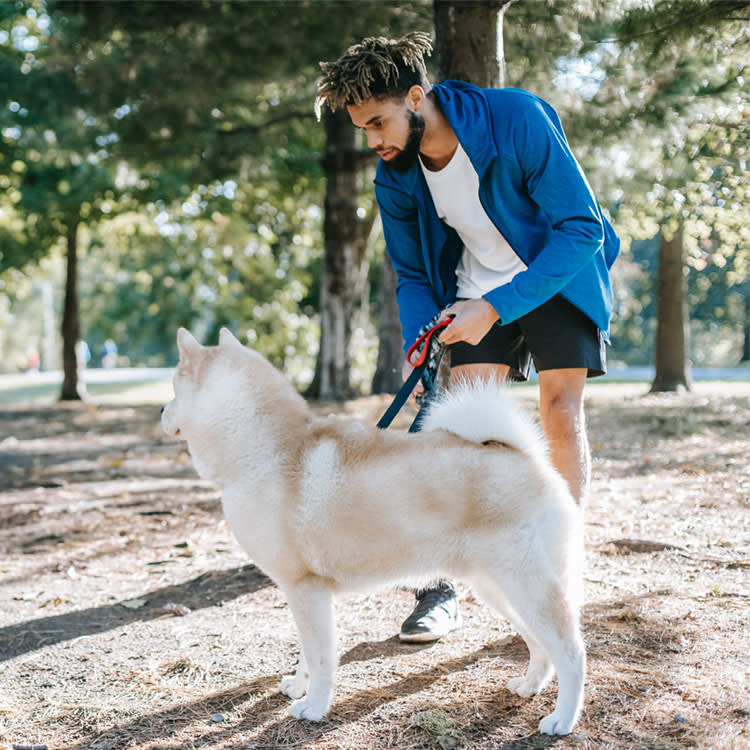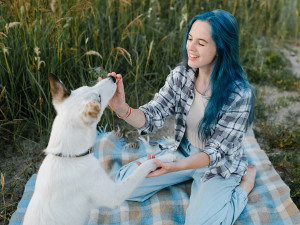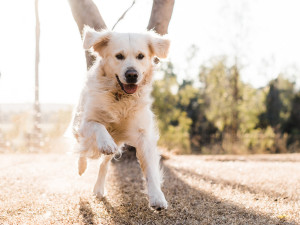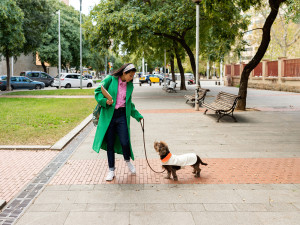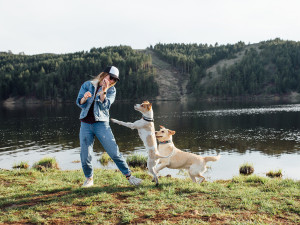How to Improve Your Dog’s Recall Training
Teach your pup a perfect recall so you can be sure they will come back, no matter what.
Dog recall training setbacks can be very disheartening. But when a dog doesn’t respond as you expect, it is usually a situation in which a dog is asked to do something that they had not yet been trained to do.
Responding appropriately to the cue to come to you when there is nothing particularly new or interesting to distract them is totally different than returning to you when someone else is feeding them treats. So, how can you know when your dog has really “gotten it” — so that you can be sure they will come back, no matter what?
Achieving perfect recall
There’s a secret to perfect recall training: There are 100 steps involved to teaching a dog to return so they can do it under any circumstances. Step one may involve calling your dog to come from five feet away in your living room, and step 100 might be calling your dog to come from 5000 feet away, while they’re chasing a deer.
Many people jump from step five to step 95 without realizing what a challenge this is for a dog. It’s like asking a student to go from addition and subtraction to reinventing calculus, figuring that the student already knows how to do math, so what’s the problem?
How much do you spend on your pet per year?
Teaching a dog what a recall cue means is often the easiest part. Proofing the dog to that cue, or getting the dog to respond a recall cue in all situations, is where it gets trickier. Just because your dog knows how to come when called doesn’t mean that they can do so when they’re enthralled by the food they’re eating, the sight of a rabbit, or a game with their best play buddy. Training your dog to leave distractions requires that you train them in a series of steps of gradually increasing difficulty.
How to teach a dog recall
It’ll take a lot of discipline on your part to avoid recall setbacks by not skipping steps. The key is that throughout your recall training work, you shouldn’t call your dog unless you are 100 percent confident that they will respond. For example, if someone is giving your pet treats, don’t try to call them back.
The odds of success aren’t in your favor. A wiser course of action is to simply go get your dog. I know: It’s not convenient. It requires only letting your dog off-leash in areas where you can go get them if they don’t come. But don’t worry — it’s only temporary.
Your response is everything.
When you call a dog to come and they don’t respond, how you handle the situation will determine your future success with dog recall training. If you do nothing, or if you keep calling them over and over, you’re teaching them not to respond unless they feel like it. Either they learn that they don’t have to come because there is no consequence for not coming, or they learn to tune out the “come” cue; it becomes background noise and loses its meaning to them. Both of these outcomes will make it harder to recall train your dog going forward.
One possible response is to go up to them, show them the treat they could have had, and then walk away. Another is to take them out of the park so they learn that if they do not respond, they do not get to stay at the park.
A third possibility is to immediately set up a similar situation as a training opportunity. Put the treat right up to their nose, move a few feet away, and call them to come. Lure them with the treat if necessary — anything to get them to come away from the distraction, and then reinforce them for doing so. Then, allow them to go back to the distraction. Allowing your dog to get both reinforcements from you and what they gave up in order to come to you makes responding to your cue a winning situation all around.
Set them up for success.
The most important factor in all dog training, but especially training dog recall, is setting up winning situations for your dog over and over again in all sorts of contexts. That’s what proofing a dog for a training cue is all about.
During training, have something better than what they gave up, so they learn that coming to you is always worthwhile. This means that if someone is giving them liver biscotti, you give them chicken. If someone is giving them a lot of nice head pets, you give them a belly rub. If someone is luring them with an ordinary ball, you offer them a super bouncy ball.
Proof your pup.
It’s hard to know for sure that your dog is recall proofed to respond to a cue in any situation if you have not explicitly practiced and trained them to handle a variety of environments. That said, the more situations and types of distractions in which your dog has learned to respond to the cue, the more likely it is they will respond appropriately in a new context.
Six dog recall training steps
Certified Applied Animal Behaviorist Dr. Patricia B. McConnell breaks recall training into six important recall training steps.
1. Prevention, prevention, prevention.
It’s hard to compete once a dog has learned that ignoring you means he gets to chase a deer or snarf down a McBurger wrapper.
2. Winning is everything.
Start teaching a recall when you can’t lose: There are no distractions, your dog is practically beside you, you have the perfect reinforcement on hand.
3. Reinforce the turn toward you.
If your dog was focused on a chipmunk, but turns their head to you when you call, you’ve won half the battle.
4. Teach stop on cue.
It only took me a couple of years of working with dogs to realize that, as mentioned above, dog recall includes several behaviors. 1) Stop what you are doing. 2) Change your focus onto me. 3) Turn around toward me. 4) Come toward me. 5) All the way.
5. Repeat, repeat, repeat.
Reinforce, reinforce, reinforce. Never stop reinforcing recall behavior. Not every time, and not necessarily for responses when all the stars were aligned, but running and chasing is such a natural behavior for a dog that stopping a chase and coming back to you is basically a circus trick.
6. Be realistic.
Your pup might seem like they’re backsliding sometimes. Don’t lose hope. Adolescent dogs are famous for forgetting everything they’ve learned as a puppy, so don’t hesitate to go back to step one (prevention) for a few months, even if your dog was a star pupil as a pup.
If you call your dog, and they visit with other dogs or even run in the other direction before getting to you, is that a perfect recall? No. But is that behavior you should reward? Yep. Though it might feel strange to reward a dog who takes so long to respond, you should definitely do so. While it isn’t the perfect recall you were looking for, you’ll need to reward your dog for leaving whatever was so interesting to return to you. If you don’t make them glad they did, they will be even less likely to do so the next time.
Eventually, with hard work and training, all situations are sufficiently similar that they can be said to be “fully proofed” for recall training. Some dogs get there faster than others, but for virtually every dog, it takes a lot of practice in a wide range of situations involving different places, with different distractions, and from different distances.
Tips on teaching your dog a reliable recall
Training your dog to reliably return to you when called — any time, anywhere — could literally save their life, so it is no exaggeration to say that a dog’s recall is the most important behavior you will ever teach them. Here are a few dog recall training tips.
1. Play is one of the best reinforcements.
If your dog learns that coming to you is fun, they’ll be more likely to respond. Call them to play tug or fetch, or let them chase you; even just running in the opposite direction often works because almost all dogs love to chase. (A note on this: Don’t chase your dog. They will learn to move away when you approach, and that can ruin their recall.)
2. Not all dogs are equally easy to train.
It’s more challenging for some dogs to learn to come when called, and while there are exceptions, there are a few breed generalizations that usually fit. Dogs bred to work closely with people and pay attention to them during that work — Collies, Shepherds, and Retrievers — are often easier to train with dog recall. Dogs bred to work independently — Terriers, scent and sight hounds, Mastiffs, and Pointers — often require more practice and time for the recall to be completely proofed. If your dog seems a little more stubborn than your friend’s, it’s probably not be your fault — and you shouldn’t lose hope.
3. Change your cue.
If your dog has learned that the word “come” has no meaning and they ignore it, consider changing the verbal cue. If a word has become irrelevant, it is often more efficient to start over. Common recall words include “here,” “front,” and “ven” (Spanish for “come”).
4. Dogs need to generalize.
Practice in many contexts is important. Place, a key factor, is particularly hard for many dogs to generalize. A recall in your yard is completely different than a recall inside the house, and a recall at the park is completely different than a recall at home — inside or out.
Other factors include distance (how far you are from your dog when calling them) and distraction level (food, other people, sounds, traffic, toys, or other dogs). Plan to train your dog everywhere — that way, they will be more likely to respond, no matter what.
